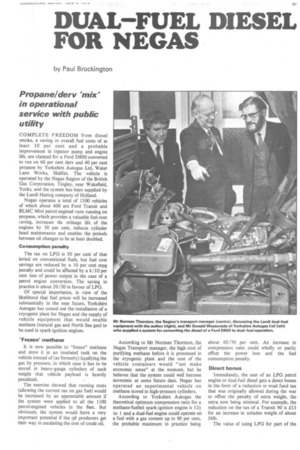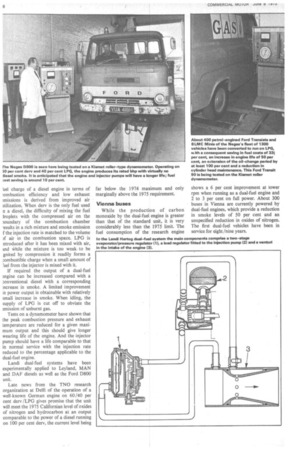DUAL FUEL DIESEL FOR NEGAS
Page 69

Page 70

If you've noticed an error in this article please click here to report it so we can fix it.
by Paul Brockington
Propanel dery "mix' in operational service with public utility
COMPLETE FREEDOM from diesel smoke, a saving in overall fuel costs of at least 10 per cent and a probable improvement in injector pump and engine life, are claimed for a Ford D800 converted to run on 60 per cent dery and 40 per cent propane by Yorkshire Autogas Ltd, Water Lane Works, Halifax. The vehicle is operated by the Negas Region of the British Gas Corporation. Tingley, near Wakefield, Yorks, and the system has been supplied by the Landi-Hartog company of Holland.
Negas operates a total of 1300 vehicles of which about 400 are Ford Transit and BLMC Mini petrol-engined vans running on propane, which provides a valuable fuel-cost aving, increases tilt mileage life of the engines by 50 per cent, reduces cylinder head maintenance and enables the periods between oil changes to be at least doubled.
Consumption penalty The tax on LPG is 50 per cent of that levied on conventional fuels, but fuel cost savings are reduced by a 10 per cent mpg penalty and could be affected by a 6/10 per cent loss of power output in the case of a petrol engine conversion. The saving in practice is about 20/30 in favour of LPG.
Of special importance, in view of the likelihood that fuel prices will be increased substantially in the near future, Yorkshire Autogas has costed out the installation of a cryogenic plant for Negas and the supply of vehicle equipment that would enable methane (natural gas and North Sea gas) to be used in spark-ignition engines.
'Frozen' methane It is now possible to "freeze" methane and store it in an insulated tank on the vehicle instead of (as formerly) liquifying the gas by pressure, in which case it has to be stored in heavy-gauge cylinders of such weight that vehicle payload is heavily penalized.
The exercise showed that running costs (allowing the current tax on gas fuel) would be increased by an appreciable amount if the system were applied to all the 1100 petrol-engined vehicles in the fleet. But obviously the system would have a very important potential if the oil producers get their way in escalating the cost of crude oil. According to Mr Norman Thornton, the Negas Transport manager, the high cost of purifying methane before it is processed in the cryogenic plant and the cost of the vehicle containers would "not make economic sense" at the moment, but he believes that the system could well become economic at some future date. Negas has operated an experimental vehicle on methane stored in high-pressure cylinders.
According to Yorkshire Autogas the theoretical optimum compression ratio for a methane-fuelled spark-ignition engine is 124 to 1 and a dual-fuel engine could operate on a fuel with a gas content up to 90 per cent, the probable maximum in practice being
about 60/70 per cent. An increase in compression ratio could wholly or partly offset the power loss and the fuel consumption penalty.
Direct bonus Immediately, the user of an LPG petrol engine or dual-fuel diesel gets a direct bonus in the form of a reduction in road fund tax that was originally allowed during the war to offset the penalty of extra weight, the extra now being minimal. For example, the reduction on the tax of a Transit 90 is .£13 for an increase in unladen weight of about 561b.
The value of using LPG for part of the
nel charge of a diesel engine in terms of :ombustion efficiency and low exhaust missions is derived from improved air itilization. When dery is the only fuel used n a diesel, the difficulty of mixing the fuel iroplets with the compressed air on the )oundary of the combustion chamber .esults in a rich mixture and smoke emission f the injection rate is matched to the volume
air in the combustion space. LPG is ntroduced after it has been mixed with air, tnd 'While the mixture is too weak, to be gnited by compression it readily forms a ombustible charge when a small amount of 'uel from the injector is mixed with it.
If required the output of a dual-fuel engine can be increased compared with a c•onventional diesel with a corresponding [ncrease in smoke. A limited improvement in power output is obtainable with relatively small increase in smoke. When idling, the supply of LPG is cut off to obviate the emission of unburnt gas.
Tests on a dynamometer have shown that the peak combustion pressure and exhaust temperature are reduced for a given maximum output and this should give longer wearing life of the engine. And the injector pump should have a life comparable to that in normal service with the injection rate reduced to the percentage applicable to the dual-fuel engine.
Landi dual-fuel systems have been experimentally applied to Leyland, MAN and DAF diesels as well as the Ford D800 unit.
Late news from the TNO research organization at Delft of the operation of a well-known German engine on 60/40 per cent dery /LPG gives promise that the unit will meet the 1975 Californian level of oxides of nitrogen and hydrocarbon at an output comparable to the power of a diesel running on 100 per cent derv, the current level being far below the 1974 maximum and only marginally above the 1975 requirement.
Vienna buses
While the production of carbon monoxide by the dual-fuel engine is greater than that of the standard unit, it is very considerably less than the 1975 limit. The fuel consumption of the research engine shows a 6 per cent improvement at lower rpm when running as a dual-fuel engine and 2 to 3 per cent on full power. About 300 buses in Vienna are currently powered by dual-fuel engines, which provide a reduction in smoke levels of 50 per cent and an unspecified reduction in oxides of nitrogen. The first dual-fuel vehicles have been in service for eight /nine years.












































































































































